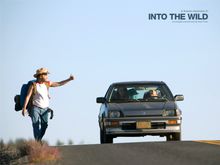Into the Wild

If you haven’t seen it, “Into the Wild” is a 2007 film written and directed by Sean Penn, and starring Emile Hirsh. It is based on the true life story of Christopher McCandless, originally recounted by John Krakauer in his 1992 book of the same name. It’s a remarkable film, in many ways, and not least of all because of the different and sometimes conflicting emotions it stirs up in the viewer. It touches on deep issues that underlie this suburban life that we share, issues of destiny and what is fundamentally important in our living.
The protagonist, Christopher McCandless, is a young man of 23 who has been raised in a middle class suburban home, who rejects all the trappings of this life for a life on the road, which ultimately takes
![]() him to the wilds of Alaska. He attends a good university, and gets his degree, and then, for complex reasons tied up with his experiences of loneliness, alienation and superficiality in his family of origin, he decides to embark on a life that is radically at odds with the generally accepted values of our culture. He burns the last of his money, and heads for a life of wandering.
him to the wilds of Alaska. He attends a good university, and gets his degree, and then, for complex reasons tied up with his experiences of loneliness, alienation and superficiality in his family of origin, he decides to embark on a life that is radically at odds with the generally accepted values of our culture. He burns the last of his money, and heads for a life of wandering.
Images: Paramount Vantage
I think that most people who view this film will have several possibly conflicting feelings about the lead character, and his actions. I know that the film certainly had that effect on me. Many people, I think, will resonate with “Alexander Supertramp” (the pseudonym McCandless adopts) and his rejection of the materialism and superficiality of the values that are often held out in our culture as the essence of middle class, and especially middle class suburban, life. “Alexander Supertramp” opts for a life unencumbered by possessions and governed by a search for freedom. He becomes, in his own words, “an aesthetic voyager whose home is the road”.
There is something exhilarating in “Supertramp’s” gradual leave-taking of all the common middle-class encumbrances. Nonetheless, as he does so, “Supertramp” simultaneously moves further and further away from any meaningful connection with any of the other people in his life. An aging hippy couple who are open in their affection towards him, a young woman who clearly loves him, an aging man who wants to adopt “Supertramp” as his son — all are left behind as he heads resolutely toward the inevitable journey “into the wild” in Alaska. Personally, I cannot help but feel that there is a tragic dimension to “Supertramp’s” refusal to engage with others in intimacy. He seems to walk away from so much love.
There is undoubtedly a naivete that surrounds the figure of McCandless / Supertramp. There is also a deep unexpressed sadness, of the kind that one finds in the lives of those who have sustained deep wounding in the womb of the family. Nonetheless, there is a deeply resonant sense of spirit in his aspiration for a way of life that does not rely on accumulation as its sole meaning, and an eros that seeks a deep connection with the natural realm that underlies all of our lives.
Supertramp becomes the embodiment of an archetypal figure, the “puer aeternis”, or eternal youth, a figure that would beckon us from our attachment to our origins, and into a continually evolving, rootless state. When he becomes “Supertramp”, McCandless in some ways seems to put his personal identity on the back burner in a dangerous way, allowing himself to be swept up by spirit and an uncompromising idealism, which simply cannot survive in the world as it is.
Nonetheless, McCandless is a sympathetic, moving figure, for he glimpses, and gives us a glimpse, of “…our own first natures, our primordial golden shadow…” in Hillman’s words (Hillman, J., The Dream and the Underworld, New York: Harper and Row, 1979). In so doing, in an unsettling and haunting way, Supertramp leads us to recall our own questions about the destiny and meaning of our lives.
Into the Wild:
Directed by Sean Penn; written by Sean Penn, based on the Jon Krakauer book; director of photography, Eric Gautier; edited by Jay Cassidy; score by Michael Brook with additional music by Eddie Vedder and Kaki King; production designer, Derek R. Hill; produced by Sean Penn, Art Linson and Bill Pohlad; released by Paramount Vantage.
Cast: Emile Hirsch as Christopher McCandless, Marcia Gay Harden as Billie McCandless; William Hurt as Walt McCandless; Jena Malone as Carine McCandless; Brian Dierker as Rainey; Catherine Keener as Jan; Vince Vaughn as Wayne Westerberg; Kristen Stewart as Tracy; and, Hal Holbrook as Ron Franz.

flower tattoo designs
I came across your article, i think your blog is interesting, keep working !